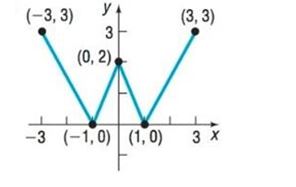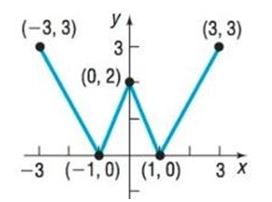
Concept explainers
In Problems 25-32, the graph of a function is given. Use the graph to find:
a. The intercepts, if any
b. The domain and range
c. The intervals on which the function is increasing, decreasing, or constant
d. Whether the function is even, odd, or neither
26.

To find: The following values using the given graph:
a. Intercepts ().
b. The domain and range set of the function.
c. Increasing intervals, decreasing intervals and constant interval if any.
d. Nature of the function (even, odd or neither).
Answer to Problem 22AYU
From the graph, concluding the following results:
a. Intercepts ().
.
b. The domain and range set of the function.
The domain of is or the interval .
The range of is or the interval .
c. The function and the . There is no constant interval in the given graph.
d. The given function is an even function.
Explanation of Solution
Given:
It is asked to find the intercepts ( and if any), domain and range, increasing intervals, decreasing intervals, and constant intervals of the function using the graph. Also, check whether the function is even, odd or neither.
Graph:

Interpretation:
a. Intercepts (): The points, if any, at which a graph crosses or touches the coordinate axes are called the intercepts.
The of a point at which the graph crosses or touches the is an , and the of a point at which the graph crosses or touches the is an .
The intercepts of the graph are the points and .
The are and 1; the is 2.
b. The domain and range set of the function.
To determine the domain of notice that the points on the graph of have between to 3, inclusive; and for each number between to 3, there is a point on the graph. The domain of is or the interval .
The points on the graph all have between 0 and 3, inclusive; and for each such number , there is at least one number in the domain. The range of is or the interval .
c. Increasing intervals, decreasing intervals and constant interval if any.
It can be directly concluded from the graph that the curve is decreasing from to , then increasing from to 0, then decreasing from 0 to 1, and at last it is increasing from 1 to 3.
Therefore, the function is increasing in the intervals and and the function is decreasing in the intervals and . There is no constant interval in the given graph.
d. Nature of the function (even, odd or neither).
By the theorem of test for symmetry, “A function is even if and only if its graph is symmetric with respect to the . A function is odd if and only if its graph is symmetric with respect to the origin”.
As the given graph is symmetric with respect to , the function is even.
Chapter 2 Solutions
Precalculus Enhanced with Graphing Utilities
Additional Math Textbook Solutions
College Algebra (7th Edition)
College Algebra with Modeling & Visualization (5th Edition)
A Problem Solving Approach To Mathematics For Elementary School Teachers (13th Edition)
Elementary Statistics
Pre-Algebra Student Edition
Elementary Statistics: Picturing the World (7th Edition)
- For each graph in Figure 16, determine whether f (1) is larger or smaller than the slope of the secant line between x = 1 and x = 1 + h for h > 0. Explain your reasoningarrow_forwardPoints z1 and z2 are shown on the graph.z1 is at (4 real,6 imaginary), z2 is at (-5 real, 2 imaginary)Part A: Identify the points in standard form and find the distance between them.Part B: Give the complex conjugate of z2 and explain how to find it geometrically.Part C: Find z2 − z1 geometrically and explain your steps.arrow_forwardA polar curve is represented by the equation r1 = 7 + 4cos θ.Part A: What type of limaçon is this curve? Justify your answer using the constants in the equation.Part B: Is the curve symmetrical to the polar axis or the line θ = pi/2 Justify your answer algebraically.Part C: What are the two main differences between the graphs of r1 = 7 + 4cos θ and r2 = 4 + 4cos θ?arrow_forward
- A curve, described by x2 + y2 + 8x = 0, has a point A at (−4, 4) on the curve.Part A: What are the polar coordinates of A? Give an exact answer.Part B: What is the polar form of the equation? What type of polar curve is this?Part C: What is the directed distance when Ø = 5pi/6 Give an exact answer.arrow_forwardNew folder 10. Find the area enclosed by the loop of the curve (1- t², t-t³)arrow_forward1. Graph and find the corresponding Cartesian equation for: t X== y = t +1 2 te(-∞, ∞) 42,369 I APR 27 F5 3 MacBook Air stv A Aa T 4 DIIarrow_forward
- Middle School GP... Echo home (1) Addition and su... Google Docs Netflix Netflix New folder 9. Find the area enclosed by x = sin²t, y = cost and the y-axis.arrow_forward2. Graph and find the corresponding Cartesian equation for: (4 cos 0,9 sin 0) θ ε [0, 2π) 42,369 I APR 27 3 MacBook Air 2 tv A Aaarrow_forward30 Page< 3. Find the equation of the tangent line for x = 1+12, y = 1-3 at t = 2 42,369 APR A 27 M . tv NA 1 TAGN 2 Aa 7 MacBook Air #8arrow_forward
 Calculus: Early TranscendentalsCalculusISBN:9781285741550Author:James StewartPublisher:Cengage Learning
Calculus: Early TranscendentalsCalculusISBN:9781285741550Author:James StewartPublisher:Cengage Learning Thomas' Calculus (14th Edition)CalculusISBN:9780134438986Author:Joel R. Hass, Christopher E. Heil, Maurice D. WeirPublisher:PEARSON
Thomas' Calculus (14th Edition)CalculusISBN:9780134438986Author:Joel R. Hass, Christopher E. Heil, Maurice D. WeirPublisher:PEARSON Calculus: Early Transcendentals (3rd Edition)CalculusISBN:9780134763644Author:William L. Briggs, Lyle Cochran, Bernard Gillett, Eric SchulzPublisher:PEARSON
Calculus: Early Transcendentals (3rd Edition)CalculusISBN:9780134763644Author:William L. Briggs, Lyle Cochran, Bernard Gillett, Eric SchulzPublisher:PEARSON Calculus: Early TranscendentalsCalculusISBN:9781319050740Author:Jon Rogawski, Colin Adams, Robert FranzosaPublisher:W. H. Freeman
Calculus: Early TranscendentalsCalculusISBN:9781319050740Author:Jon Rogawski, Colin Adams, Robert FranzosaPublisher:W. H. Freeman
 Calculus: Early Transcendental FunctionsCalculusISBN:9781337552516Author:Ron Larson, Bruce H. EdwardsPublisher:Cengage Learning
Calculus: Early Transcendental FunctionsCalculusISBN:9781337552516Author:Ron Larson, Bruce H. EdwardsPublisher:Cengage Learning





